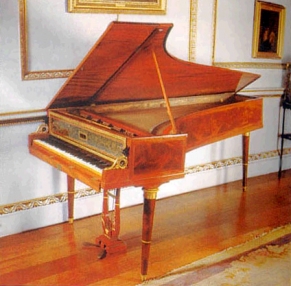Erard in Paris
Grand piano, Erard Fréres, Paris 1819, Cobbe Collection, Hatchlands (Surrey)
Already in the early 19th century Franch pianos looked fairly „modern“ because of their outline predating present custom. The sound character is more similar too to present grands because its action approaches what has become modern standard after about 1840.
music sample:
(excerpt) Ignaz Moscheles, Sonate mélancolique op. 49 (1814)
played by Michael Krücker
Instrument: Erard 1844
Not unlike in Britain piano making in France was heavily influenced by German-speaking immigrants like the Érard family (Erhard, from Strasbourg) and Pleyel (lower Austrian). But piano manufacture in Paris faced some adverse circumstances, for during the French revolution makers and buyers of those instruments were considered suspicious collaborators and sympathisers of the Ancien regime. Many immigrants to Paris for political and economic reasons tried to leave France, like the brothers Érard who fled to London and worked for Broadwood and soon opened an own branch in Great Marlborough Street.
After their return to Paris squares and grands were soon shaped following English designs. After the 1820s Sébastien Érard bit by bit developed the essentisl elements of the modern piano: the double escapement action (double échappement), the use of metal bars for reenforcement against increased string tension (barrage métallique; also in London c1820), felt covers for hammers (after Jean-Henri aka Johann Heinrich Pape, working for Erard), the metal frame following after c1850 (after Jonas Chickering 1830, cast iron frame 1843) and the attemts at oblique bass stringing. In these days the Paris manufacturers were, considering the refining of components, the most progressive of their time.
Animation of an Erard grand action
In fact this led to another re-invention of the piano because playing and sound differed immensely from older models. But the requirements of concerts in bigger and bigger concert halls (Erard as well as Pleyel built the biggest then in Paris) required a potential of volume which could only achieved by increase of string tension and an action that could set heavier and bigger hammers in motion in comparable speed. This meant a loss of some traditional qualities like light weight touch, short key travel, the variety of sound nuances from low to high asf..
Many of these novelties succeeded internationally but the decisive factors behind this were not the "old" competitors nor the Paris firms, but their imitators in the USA and Germany which dominated the world market after c1870.
So in the late 19th century the "revolutionaries" Erard and Pleyel transmuted into „traditionalists“ by their late transgressions to industrial production, keeping parallel stringing for a long time and in many details ignoring the zeitgeist for a long time. But if one is lucky to hear a well preserved grand of these from about 1900 the best qualities of their instruments can still be experienced and admired: a homogenous sound and a sonority and warmth of sound never achieved later which is still so indispensable for a piano composition by Claude Debussy.
© Greifenberger Institut für Musikinstrumentenkunde | info@greifenberger-institut.de




